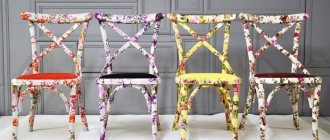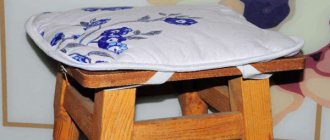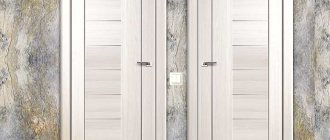Selection of materials
Before you start working at home, you need to select materials for upholstery and soft substrate. You can use what you have on hand, or purchase products from specialized furniture stores. Particular attention should be paid to the structure and density of the fabric.
For soft substrate
For a soft backing, you can use foam rubber. This is the most common and cheapest material. Its more expensive and high-quality analogue is padding polyester. However, experts recommend using natural options, for example:
- copra;
- batting;
- horsehair;
- burlap.
The recommended thickness of the cushion is 3–5 cm for the back and 6.5–7.5 cm for the seat. If the plywood base does not have springs, it is better to make all 10 cm. Otherwise, the person will feel discomfort while sitting on the chair for a long time.
Foam rubber
Sintepon
Copra
Batting
Horsehair
Sackcloth
For upholstery
The fabric for upholstering the chair should be dense and hold its shape well. Another important requirement is wear resistance. The material should be easy to clean from contamination.
| Option | Peculiarities | Advantages | Flaws |
| Leather | Natural, environmentally friendly material that does not cause allergies. Available in a variety of colors | It lends itself well to mechanical stress, which is very convenient when re-upholstering. | May crack or warp due to sudden temperature changes. Cheap options look similar to leatherette |
| Jacquard | Consists of multi-colored threads or monochrome fibers. Has a textured surface | Long service life, durability | Heavy fabric, quite difficult to care for |
| Flock | Material with a small pile, the composition includes polyester and cotton. The base is covered with a thin layer of glue | Wear-resistant, easy-care fabric | High price |
| Velvet | Smooth fabric with a small pile, practically does not wrinkle | The fabric is easy to work with and upholstering the chair is very simple. Spectacular design | Quickly begins to shine and fade if not properly cared for. |
| Chenille | Between the spiral of two threads there is a pile. Looks like velor | Inexpensive, resistant to external influences | It is difficult to remove old, ingrained dirt |
| Tapestry | Has a dense rough texture, includes 3 layers of threads | Easy to wash and remove stains. Durable and comes in a variety of patterns | Wears out quickly, fades in case of prolonged exposure to the sun |
The list of recommended materials also includes faux leather. It has a smooth, pleasant to the touch structure. Its main advantage is its spectacular appearance. Disadvantages - rapid wear.
When choosing material for children's furniture, you should choose options that do not cause allergic reactions. It is not recommended to use light-colored fabric, as it quickly loses its presentation.
Leather
Jacquard
Flock
Velvet
Chenille
Tapestry
Tips for choosing upholstery fabric
To reupholster chairs, you need high-quality upholstery fabric. Only furniture fabric is recommended, since decorative fabrics will not withstand constant loads and will wear out quickly. The material must be durable and retain its shape. Important requirements for the composition are ease of cleaning with a brush and soapy water and washing.
The most common types of dense fabrics for upholstering furniture are: flock, jacquard, chenille, tapestry, velor, boucle, etc. Interior items are also finished with leather, eco-leather, etc.
Read on our website
How to update an old chair with a backrest with your own hands? Before you update an old chair with a backrest with your own hands, you need to examine the condition of the furniture. Before restoration...
Flock is a popular material for finishing upholstered furniture. The fabric consists of cotton (35%) and polyester (65%). The material has a fine pile, is comfortable to use, durable, high quality, and wear-resistant. Caring for flock is simple; the fabric can be easily cleaned with a brush and soapy water, since a thin layer of adhesive is applied to the base of the fabric during production.
Jacquard is often used for upholstery of furniture, because the material is dense and has a textured surface. Fabric is produced in 2 ways: the fabric is woven from threads of different colors or created using single-color fibers of a neutral shade. Monochrome canvases are additionally decorated with prints from colored paper using a hot press. The advantages of jacquard are strength and wear resistance. However, caring for the canvas is difficult.
The advantages of velor are the smooth surface of the front part and the strength of the composition. The material has a small pile. The canvas is characterized by low creasing, so it is optimal for finishing pieces of furniture.
Chenille is similar in quality and texture to velor. Chenille fabric is made by weaving pile between two threads, which are connected in a spiral. The advantages of the canvas are high strength, affordable price, practicality.
Bouclé fabric is also used in furniture decoration. The fabric is practical, light, soft and elastic. The material drapes well, has water-repellent properties, and is resistant to deformation. Threads for creating fabric can be colored or plain. The material is easy to finish and allows you to correct defects and uneven seams.
Tapestry fabric is often used to upholster a chair. The material is heavy, consists of 3 layers, the weave of the threads is dense. To make a tapestry, synthetic fibers or natural yarn are used. Artificial threads are added to improve the performance characteristics of the material. Patterns and geometric patterns on the canvas are created by connecting threads and yarn of different shades. It is necessary to take into account that tapestry upholstery will not suit high-tech and modern styles.
Required Tools
Before you reupholster the chairs with your own hands step by step, you should take care of the tools. To work with textiles you will need a sewing machine. To remove old upholstery you need an anti-stapler. The frame is dismantled using screwdrivers of different diameters and pliers. The home handyman should also prepare in advance:
- thick cardboard;
- glue and a brush for it;
- furniture stapler with staples;
- nails and hammer;
- measuring instruments - tape measure, square, measuring tape.
Reupholstering a chair with your own hands can be done in different ways. If you don't have a furniture stapler, you can use wallpaper nails (with flared heads) instead. They fit smoothly into the upholstery and hold it well. Some craftsmen also use an attracting strip with screws, which reliably hides the seams (in this case, you need to pull the fabric simultaneously along the entire perimeter). However, special staples still last longer. A hammer can be successfully replaced with a rubber mallet, since reupholstering furniture does not require much physical effort.
How to choose fabric colors for chair upholstery
Some of the nuances of upholstery replacement work include what pattern and texture of fabric is supposed to be used.
A plain fabric does not raise any questions, and upholstering a chair with fabric of a single uniform color is an elementary task. The work will require 1-2 meters of fabric.
Plain fabric does not raise any questions
Fabric with a pattern, such as checkered or striped, will require a more responsible approach. The required footage of such fabric is 2-3 meters, since you will need to adapt to the pattern.
Working with patterned material involves trying it on convex areas of the seat, and preliminary visualization of how the pattern will be deformed due to the variety of shapes and thicknesses of chair seats.
Working with patterned material involves trying it on the convex areas of the seat
In addition, if a cage is chosen as a pattern, you need to decide what is more beautiful - to apply the upholstery fabric evenly (line to line) or diagonally (diamonds). The same applies to stripes, photo prints, abstractions, imitation skins, floral and rapport (repeating) patterns, for example, jacquard fabrics.
It’s worth checking in advance how the pattern will roughly look.
It’s worth checking how the pattern will roughly look in advance, so that when finished, the work done doesn’t look like it was done hastily.
Stages of work
Restoration and upholstery of chairs with leather consists of several stages, performed in a certain sequence. The main thing is to know how to change the upholstery. First, the product is freed from old fabric. The next step is dismantling the frame. Then new material with a soft backing is attached and the back is updated.
Removing old upholstery
Before you reupholster a chair, you need to expose its frame. You will need a special regulator to remove furniture staples. It can be purchased in specialized stores. Sequencing:
- Align the edge of the adjuster with the center of the bracket, lift the tool up, pressing on the frame.
- Wait until one of the ends of the fastener pops out.
- Grab the staple with pliers and pull it out.
- Repeat the same several times, depending on the number of fasteners.
After this, the fabric is removed. First, the seat of the chair is exposed. Then the upholstery is removed from the back.
Under no circumstances should you forcefully tear out the upholstery: intense mechanical stress can damage the frame. You need to remove old fabric from the seat in stages, starting from the edges and gradually moving to the center.
Disassembling the frame
To disassemble the wooden frame into its components when reupholstering a kitchen chair, you will need a mallet. You need to tap the joints of the parts with a tool, and the product will easily fall apart into its components - the back, the base for the seat and the legs. The good condition of the parts is indicated by the absence of fungus and mold, scratches, nicks and chips. If the old parts are rotten, they need to be replaced (this often happens when the chair has been in a damp room for a long time).
Next, you should check the connections and remove all unstable, loose fasteners. The disassembled parts are cleaned and re-glued.
Making a soft substrate
The size of the backing on the chair should correspond to the length and width of the seat (plus a seam allowance of 1.5–2 cm around the entire perimeter). Then, if there is excess fabric left, the protruding ends can be carefully cut off. Step-by-step instruction:
- The pattern is made on paper or directly on the material. The shape of a soft pillow can be square or round, it all depends on the seat.
- The finished product is cut out with sharp tailor's scissors.
- It is placed on the seat using glue, which dries in 10–15 minutes.
- It is better to additionally add a small layer of synthetic padding on top.
You can make a soft base from horsehair or dried grass the old fashioned way. These materials are good because they last a long time. Also, dust mites do not breed in them.
Remove traces of old upholstery
Cut out the soft pad
Stick to the seat
Attaching new upholstery
When replacing the upholstery of a chair, you must perform all stages of the work correctly. The fabric tension should be as tight as possible. There should be no folds. You don't need to hit them with a hammer with full force. Step-by-step instructions for attaching the upholstery:
- Secure in two places in the center - in the front and back.
- Pull and secure left and right.
- Evenly distributing the load, fasten it on both sides in turn.
- Repeat step 3 back and front.
You can use wallpaper nails, but it will take longer. They should be short so as not to tear the soft backing. In this case, when repairing a chair with your own hands, you will additionally need a tape made of dense material.
Align the main fabric on the seat
Stretch and secure in several places with a stapler
Attach fabric around the perimeter
Finished seat
Restoration of the back of a chair
Working with the back consists of two stages - covering it with fabric and applying paint and varnish. If there are cracks, they need to be puttied or sealed. The step by step guide will be as follows:
- Pull the upholstery over the back of the product.
- Fix the fabric with a stapler in the direction from the center to the periphery.
- Glue foam in front.
- Secure the fabric with the edging to the edge.
Next, the excess fabric for upholstering the chairs is cut off. The upholstery is decorated with braid to hide staples or nails. After this, you can varnish and paint the back. Acrylic is best. Water-based substances should not be used; such coatings wear off quickly.
Nuances of backrest restoration
To change the back upholstery, it should be dismantled, putty or seal the existing cracks, and chips should be cleaned. After this, you need to install the backing, cover it with fabric, apply paint and varnish. The process then consists of the following steps:
- Cut the rough fabric according to the pattern with a margin of up to 3 cm to make pulling more convenient. Pet her.
- Pull the upholstery over the backrest on one side.
- Secure the fabric with a stapler, moving from the center to the ends.
- Glue the soft backing to the front.
- Fasten the fabric tightly to the edges.
- Repeat the same with the finishing cloth.
Homemade and chemical compositions for cleaning chair stains, stages of work
The excess should be carefully trimmed and the edges should be coated with glue. Staples or nails will not be visible if the chair is decorated with braid, which should be secured to the edges. It is convenient to do this by attaching them with pins, which can be removed about two hours after gluing. Then the product remains to be painted (acrylic paint is optimal, since the water-based composition will quickly wear off) and varnished. A chair with a back should look neat both in front and behind, and on the sides. You need to remember about the underside; it should also be stretched with fabric.
Features of re-tensioning the base with belts or a snake spring
To restore old chairs on canvas, you will need synthetic rubberized belts of approximately the same width. They are fixed in the center of the bar towards the frame. The new strip is secured with staples, rotated and fixed again. Then it is secured and tensioned on the opposite side. A soft substrate is placed on top. The tools you will need are a steelyard and a furniture stapler with staples.
You need to pull with a force of 1 kg on the seat, 8 kg on the back. When one side of the belt is already secured, a steelyard is hooked to the other end and pulled until the desired number appears. The desired length is marked with a marker.
To replace the snake spring, it must be fixed to the frame using special fasteners, and they, in turn, must be mounted using brackets on long legs. When positioned correctly, this part has a slightly curved shape. If you want the upholstery to last longer, place a fabric layer between the twisted wire and the pillow. This is done so that the foam rubber does not fray over time.
If the reupholstery of the chair is successful, you can try restoring other, larger upholstered furniture: an armchair, a sofa, a kitchen corner. The work is carried out according to the same principle, only the dimensions and shape of the product change. Restoring old broken things will help you save on buying new ones, and will also become a fun hobby for people who love to make things.











